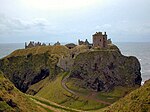Portal:History/Featured article/June, 2011

The High Middle Ages of Scotland encompass Scotland in the era between the death of Domnall II in 900 AD and the death of king Alexander III in 1286. Alexander's death was an indirect cause of the Scottish Wars of Independence.
In the tenth and eleventh centuries, northern Great Britain was increasingly dominated by Gaelic culture, and by a Gaelic regal lordship known in Gaelic as "Alba", in Latin as either "Albania" or "Scotia", and in English as "Scotland". From a base in eastern Scotland north of the River Forth, the kingdom acquired control of the lands lying to the south. It had a flourishing culture, comprising part of the larger Gaelic-speaking world.
After the twelfth-century reign of King David I, the Scottish monarchs are better described as Scoto-Norman than Gaelic, preferring French culture to native Scottish culture. They fostered and attached themselves to a kind of Scottish "Norman Conquest". The consequence was the spread of French institutions and social values. Moreover, the first towns, called burghs, appeared in the same era, and as these burghs spread, so did the Middle English language. To a certain degree these developments were offset by the acquisition of the Norse-Gaelic west, and the Gaelicization of many of the noble families of French and Anglo-French origin. By the end of this period, Scotland experienced a "Gaelic revival" which created an integrated Scottish national identity. Although there remained a great deal of continuity with the past, by 1286 these economic, institutional, cultural, religious and legal developments had brought Scotland closer to its neighbours in England and the Continent. By 1286 the Kingdom of Scotland had political boundaries that closely resembled those of modern Scotland.
(more...)
